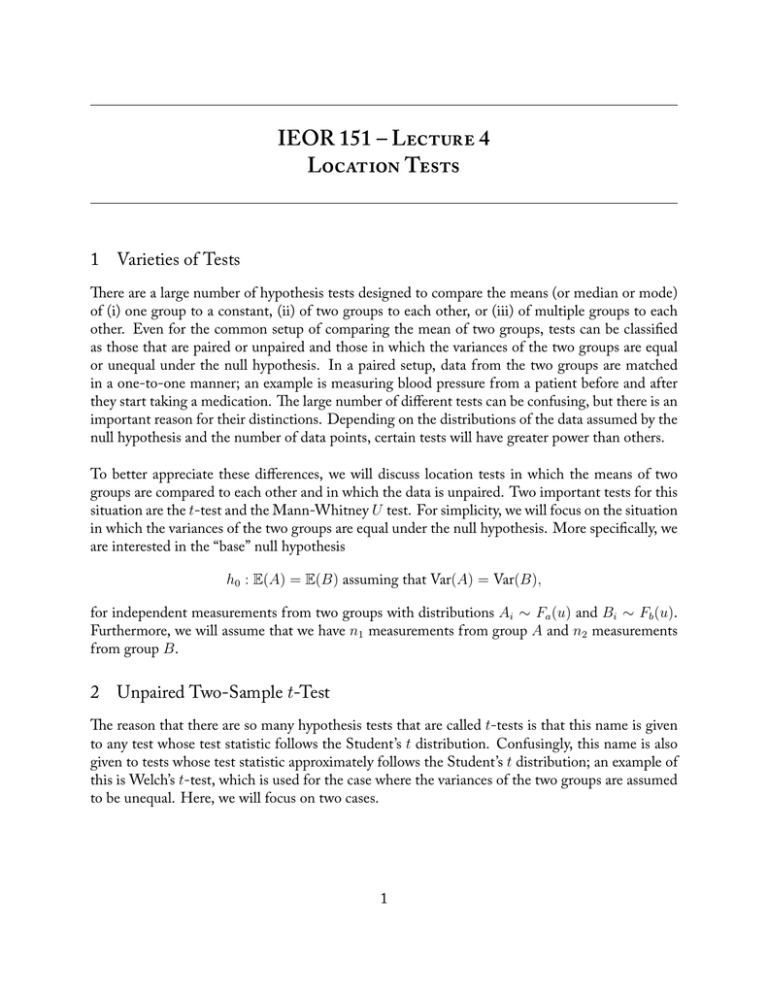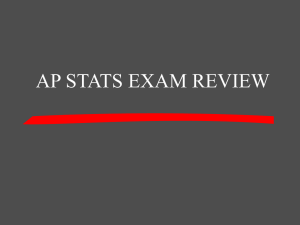IEOR 151 – L 4 L T 1 Varieties of Tests
advertisement

IEOR 151 – L 4
L T
1
Varieties of Tests
ere are a large number of hypothesis tests designed to compare the means (or median or mode)
of (i) one group to a constant, (ii) of two groups to each other, or (iii) of multiple groups to each
other. Even for the common setup of comparing the mean of two groups, tests can be classified
as those that are paired or unpaired and those in which the variances of the two groups are equal
or unequal under the null hypothesis. In a paired setup, data from the two groups are matched
in a one-to-one manner; an example is measuring blood pressure from a patient before and after
they start taking a medication. e large number of different tests can be confusing, but there is an
important reason for their distinctions. Depending on the distributions of the data assumed by the
null hypothesis and the number of data points, certain tests will have greater power than others.
To better appreciate these differences, we will discuss location tests in which the means of two
groups are compared to each other and in which the data is unpaired. Two important tests for this
situation are the t-test and the Mann-Whitney U test. For simplicity, we will focus on the situation
in which the variances of the two groups are equal under the null hypothesis. More specifically, we
are interested in the “base” null hypothesis
h0 : E(A) = E(B) assuming that Var(A) = Var(B),
for independent measurements from two groups with distributions Ai ∼ Fa (u) and Bi ∼ Fb (u).
Furthermore, we will assume that we have n1 measurements from group A and n2 measurements
from group B.
2
Unpaired Two-Sample t-Test
e reason that there are so many hypothesis tests that are called t-tests is that this name is given
to any test whose test statistic follows the Student’s t distribution. Confusingly, this name is also
given to tests whose test statistic approximately follows the Student’s t distribution; an example of
this is Welch’s t-test, which is used for the case where the variances of the two groups are assumed
to be unequal. Here, we will focus on two cases.
1
But before we consider those two cases, it is useful to give some definitions. e density function
of a Student’s t distribution with ν > 0 degrees of freedom is given by
(
)− ν+1
2
2
Γ( ν+1
)
x
f (u) = √ 2 ν 1 +
,
ν
νπΓ( 2 )
where Γ(·) is the gamma function. An alternative characterization is that the Student’s t distribution is the distribution of the random variable T defined as
T =√
Z
V /ν
,
where Z ∼ N (0, 1) and V ∼ χ2ν has a chi-squared distribution with ν degrees of freedom.
2.1
N A B
In the first case, we will amend the base null hypothesis with normality. at is, our null hypothesis
for this section will be
H0 : h0 and Ai , Bi ∼ N (µ, σ 2 ),
where µ = E(A) = E(B) and σ 2 = Var(A) = Var(B). A test statistic for this null hypothesis is
given by
√
(An1 − B n2 )/ 1/n1 + 1/n2
√
,
t=
Sab /(n1 + n2 − 2)
√
(n1 − 1)Sa2 + (n2 − 1)Sb2 ),
∑ 1
∑ 1
with Sa2 = n11−1 ni=1
(Ai − An1 )2 and Sb2 = n11−1 ni=1
(Bi − B n1 )2 . We will give some intuition
for why the statistic t has a Student’s t distribution with n1 +n2 −2 degrees of freedom. e original
derivation by Fisher (though the test was invented by Gosset working at the Guinness brewery in
Dublin, Ireland) uses the rotational symmetry of the problem to essentially provide a geometric
argument. We will take an alternative approach:
where we define
Sab =
1. Using results about jointly Gaussian random variables we can show that An1 and Ai − An1
(as well as B n1 and Bj − B n1 ) are independent. Since the numerator is a function of An1
and B n1 , and the denominator is a function of Aj − An1 and Bj − B n1 , the numerator and
denominator are independent.
2. It can be shown that Sa2 ∼ σ 2 /(n1 − 1) · χ2n1 −1 and Sb2 ∼ σ 2 /(n2 − 1) · χ2n2 −1 . But because
χ2k1 + χ2k2 ∼ χ2k1 +k2 for independent χ2k1 and χ2k2 , we have that (n1 − 1)Sa2 + (n2 − 1)Sb2 ∼
σ 2 χ2n1 +n2 −2 .
2
3. Note that An1 − B n2 ∼ N (0, σ 2 /n1 + σ 2 /n2 ) = N (0, σ 2 · (1/n1 + 1/n2 )).
√
4. Last, observe that t ∼ σN (0, 1)/ σ 2 χ2n1 +n2 −2 /(n1 + n2 − 2). But using the alternative
characterization, this means that t is described by the Student’s t distribution with n1 +n2 −2
degrees of freedom.
2.2
N-N A B L S S
In the second case, we will amend the base null hypothesis with non-normality. at is, our null
hypothesis for this section will be
H0 : h0 and Ai , Bi are non-normal but have finite variance σ < ∞ .
It is the case that for large sample sizes, the test statistic t defined above is well approximated by a
normal distribution N (0, 1). To see why, suppose that n2 = αn1 for some α ∈ (0, 1). Next, note
the following:
√
√
d
d
1. e Central Limit eorem implies that n1 (An1 − µ) → N (0, σ 2 ) and n2 (B n2 − µ) →
N (0, σ 2 ). Next note that
√
√
(An1 − B n2 )/ 1/n1 + 1/n2 = (An1 − µ + µ − B n2 )/ 1/n1 + 1/n2
√
√
n1
n2
=√
(An1 − µ) − √
(B n2 − µ).
1 + n1 /n2
n2 /n1 + 1
√
√
√
√
But because (i) 1/ 1 + n1 /n2 = 1/ 1 + 1/α, (ii) 1/ 1 + n2 /n1 = 1/ 1 + α, and (iii)
Ai , Bi are independent, we have from the Continuous Mapping eorem that
√
d
(An1 − B n2 )/ 1/n1 + 1/n2 → N (0, σ 2 /(1 + 1/α) + σ 2 /(1 + α)) = N (0, σ 2 ),
since some algebra gives that 1/(1 + 1/α) + 1/(1 + α) = 1.
2. Next, note that some algebra gives that E(Sa2 ) = σ 2 . Also, note that we can rewrite Sa2 as
1
1 ∑
(Ai − An1 )2
=
n1 − 1 i=1
n
Sa2
1
1 ∑
2
=
(A2i − 2Ai An1 + An1 )
n1 − 1 i=1
n
1
1
2An1 ∑
n1
1 ∑
2
A2i −
Ai +
An1 .
n1 − 1 i=1
n1 − 1 i=1
n1 − 1
n
=
n
Now by the weak law of large numbers, we have that 1/n1
us, using the Continuous Mapping eorem gives
p
∑n 1
i=1
p
A2i → E(A2i ) and An1 → µ.
Sa2 → E(A2i ) − 2µ2 + µ2 = E(A2i ) − µ2 = σ 2 ,
where the equivalence to σ 2 is by definition of variance.
3
3. Finally, we note that some algebra yields
√
p
Sab /(n1 + n2 − 2) → σ. Using Slutsky’s eod
rem to put everything together, we get that t → N (0, 1).
3
Mann-Whitney U Test
For this hypothesis test, we will add additional elements to the hypothesis test. One situation in
which the Mann-Whitney U Test can be applied is if the null hypothesis is
H0 : h0 and Fa (u) = Fb (u).
In fact, this test is not applicable if the distributions have different variances but the same means.
e test works as follows. e data Ai , Bi is placed into a single list that is sorted by ascending
order, and the rank of a data point is defined as its ordinal position in the single list. Next, the sum
of the ranks for all data points Ai is computed – call this value Ra . e test statistic U is defined as
U = min{Ra − n1 (n1 + 1)/2, n1 n2 − Ra + n1 (n1 + 1)/2}.
e p-value is then computed using the distribution of U . e computation of this is beyond the
scope of this class, but there are two points of intuition. e first is that the distribution of U can
be approximated by N (n1 n2 /2, n1 n2 (n1 + n2 + 1)/12). e second is that U is a measure of how
evenly mixed the data is, with more extreme values indicating non-even mixing. If Ai , Bi have
identical distributions, then you would expect the data to be evenly mixed.
4





